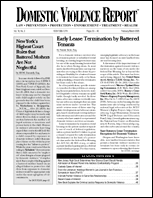Post-Separation Abuse Featured in the New Duluth Power and Control Wheel
Author: Chris Godsey.; Renita Robinson.
Source: Volume 18, Number 06, August/September 2013 , pp.81-83(3)

next article > |return to table of contents
Abstract:
Battering survivors, their advocates, and many practitioners know that when a woman escapes a man who abuses her, she and their children usually face intensified dangers. Experience tells them that he will begin using their children, the effects of his past abuse, and his potential for more violence as tools in new forms of force in his efforts to engage systems and institutions in maintaining power and control over her. In more than 20 years of working to protect battered mothers and their children while holding fathers who batter accountable, the Duluth Family Visitation Center (DFVC) has become well-versed in articulating and accounting for post-separation violence dynamics. DFVC is a division of the Domestic Abuse Intervention Programs (DAIP), the organization that in the early 1980s developed the Duluth Model philosophy for responding to domestic violence and the original “Power and Control Wheel.” The Model and the Wheel are now international standards for people and organizations working to understand and end men’s violence against women. This article is a first-person account; the authors are directors of the project. The “Using Children Post Separation Wheel” is reproduced here.Keywords: Safe Transitions Healthy Families Program; how violent men use children to maintain post-separation power and control; manual “Naming the Tactics: Men’s Use of Children to Maintain Post-Separation Power and Control over Women”; post-separation
Affiliations:
1: DAIP-National Training Project; 2: DAIP-Duluth Family Visitation Center.